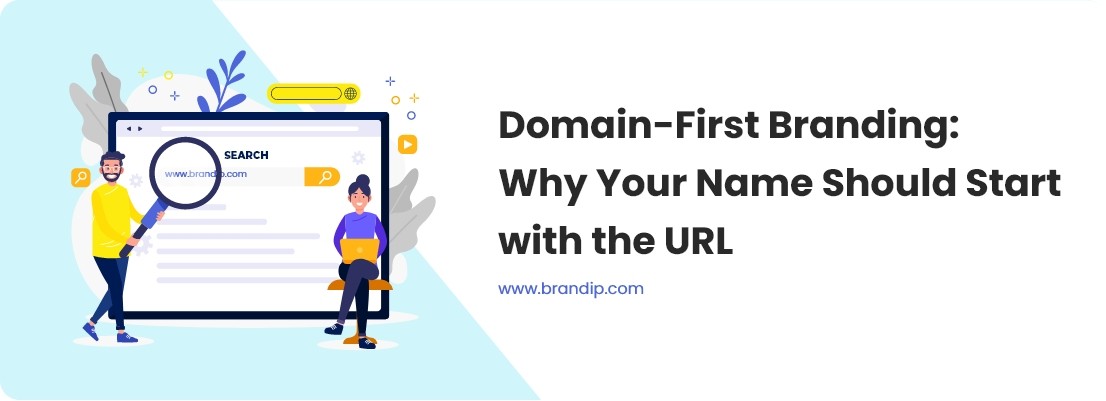
Domain-First Branding: Why Your Name Should Start with the URL
In today’s digital-first world, your brand's identity often begins not with a storefront, business card, or even a logo — but with a URL. Before a customer ever interacts with your product or service, they will likely type your web address into their browser. This is why more businesses are embracing domain-first branding — a strategy where your brand name is built around the availability and memorability of your domain.
Gone are the days when businesses would create a name and then scramble to find a matching web address. Today, branding with a domain name is a foundational step, ensuring brand consistency, credibility, and discoverability from day one.
Let’s explore why your brand’s name should begin with the URL and how you can implement a URL‑based branding strategy effectively.
What Is Domain‑First Branding?
Domain‑first branding is the practice of selecting your business or brand name based primarily on the availability of a strong, relevant, and easy‑to‑remember domain name. Rather than starting with a clever name and hoping to find a matching URL, you start the branding process by researching domain names and then build your brand around the best fit.
This approach puts your online presence at the forefront of your brand strategy. It acknowledges that in a hyper‑connected, digital marketplace, your domain name isn’t just a web address — it’s your first impression, your storefront, and a critical part of your identity.
Why Domain Availability Shapes Brand Identity
Your brand name may be catchy and meaningful, but if choosing a brand name with a URL means settling for awkward compromises (like “get” or “official” prefixes, or multiple hyphens), you risk losing customers to better‑branded competitors or even to typos.
Consider this: If your brand is called “BlueSpoon” and bluespoon.com is already taken by an unrelated entity, you may be forced into something like bluespoonco.com or getbluespoon.net. These variations are not only harder to remember — they also dilute your brand authority and could lead to lost traffic and trust.
On the other hand, securing bluespoon.com means your brand and domain are in perfect alignment. That kind of consistency builds instant credibility.
Benefits of a URL‑Based Branding Strategy
-
Improved Discoverability
Search engines prioritize domain relevance. If your domain exactly matches your brand name or primary keywords, it helps with SEO and ensures your audience finds you more easily. This is especially important for startups or new businesses looking to gain traction online. -
Brand Memorability
People remember short, clear, and intuitive domains. With URL‑based branding, your name and web address are one and the same, minimizing confusion and making it easier for customers to recall and return. -
Stronger Brand Cohesion
When your business name, domain name, and social handles are aligned, it reinforces a consistent brand message across all digital touchpoints. This unity boosts brand trust, especially in competitive spaces. -
Higher Perceived Value
A premium, exact‑match domain signals professionalism. Investors, partners, and customers alike perceive businesses with strong domain names as more legitimate and forward‑thinking.
How to Pick a Domain for Your Brand
If you’re wondering how to pick a domain for your brand, start with the following steps:
Step 1: Brainstorm Domain‑First
Instead of picking a name first, brainstorm with domain availability in mind. Use domain search tools to explore combinations, creative spellings, or trending keywords in your industry.
Step 2: Prioritize Simplicity
Avoid long, complex, or hyphenated domains. A simple domain is easier to share verbally, spell correctly, and type without errors.
Step 3: Check for Trademarks and Social Handles
Your domain should be legally available and ideally match across major platforms (Instagram, LinkedIn, X, etc.). This helps secure a cohesive digital identity.
Step 4: Consider New Domain Extensions (TLDs)
While .com remains king, other extensions like .co, .io, .tech, or .ai can work depending on your industry. Just ensure the extension adds relevance and clarity — not confusion.
Step 5: Think Long‑Term
Choose a domain that can scale with your brand. Avoid ultra‑niche terms that might limit you as your business grows.
Real‑World Examples of Domain‑First Success
Many successful companies built their identities around domain‑first thinking:
Dropbox famously chose its name after securing dropbox.com, despite being previously called “Evenflow.”
Buffer started as bfffr.com before realizing the power of having a clean, brandable URL and transitioning to buffer.com — a move that increased credibility.
Brandip offers a curated approach to branding with domain name as a strategic asset from the outset.
Final Thoughts
Domain‑first branding isn’t just a trend — it’s a necessity in an online‑first world. The process of choosing a brand name with URL availability in mind ensures your business is visible, credible, and consistent from the start.
By embracing a URL‑based branding strategy, you position your brand for long‑term growth, stronger digital presence, and deeper trust with your audience. Don’t let your dream brand be held back by a domain that doesn’t fit. Instead, let your domain lead the way — and watch your brand grow around it.
Ready to find your perfect domain‑first brand name? Whether you're launching a startup or rebranding an existing business, begin your journey with the URL in mind — and set your brand up for digital success.